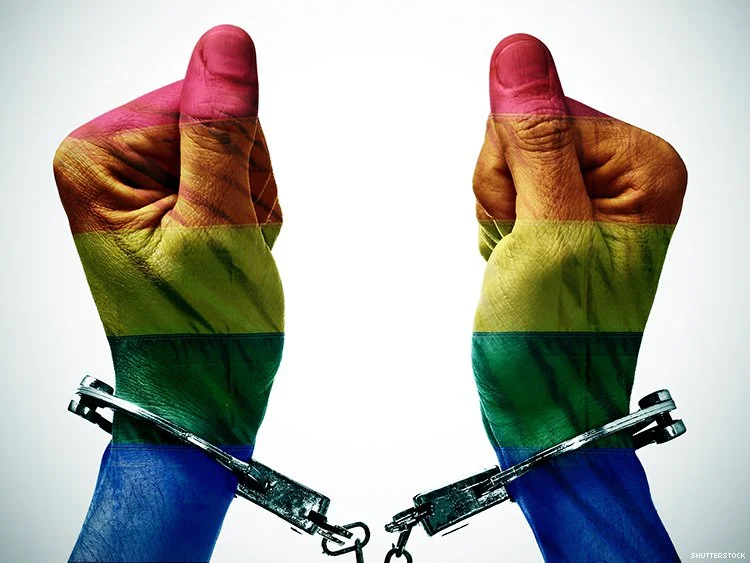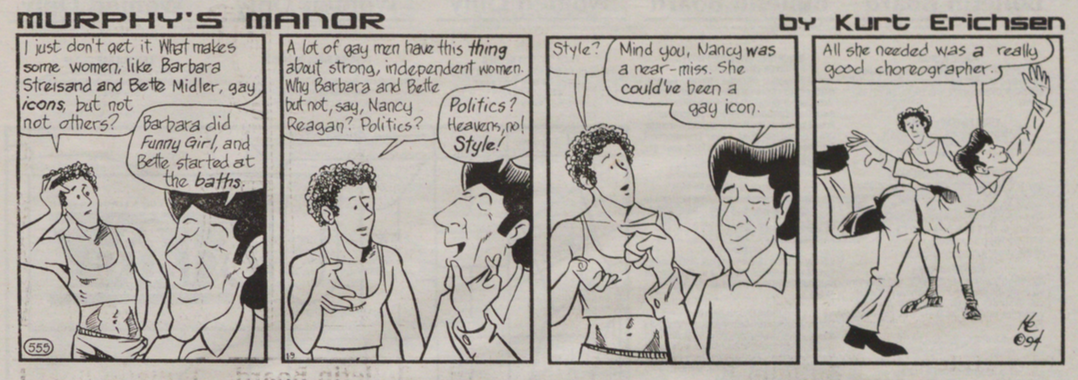By Evan Brechtel
There’s a thrilling moment in the 1930 film Morocco. Marlene Dietrich—famously clad in top hat and tuxedo—entertains a crowded bar before singling out one woman, pulling a flower from her hair and cradling it between her fingers. “May I have this?” she asks the captivated woman.
“Of course,” she replies. Dietrich briefly caresses the woman’s chin, then—in 1930—she kisses the woman on the mouth. The woman hides her blushing face behind a fan and the patrons of the bar erupt in laughter. It’s only a flicker of affection intending to parody the entitlement of men to women’s bodies, yet I often get chills watching this moment, wondering what queer eyes must have thought upon first seeing it.
Sixty-two years later, while writing her obituary in Gay and Lesbian Humanist, Terry Sanderson would describe Dietrich as “the last of the great gay icons.” He would go on to say, “There was always a huge gay contingent, worshiping at the shrine of a creature that was only half human—the other half was pure myth.” Sanderson’s reverence for Dietrich is one of countless incidents of historical adoration between queer people (most famously, gay men) and our icons.
While this reverence may seem hokey today, in the early twentieth century, these icons were not merely entertainers. They were essential to our community (many of them a part of it themselves) in a time mainstream cinema-goers ignored our existence, if not outright vilified it. But despite that social ostracism, we would see our own world-weariness reflected back to us in artists like Billie Holiday and Edith Piaf. Tallulah Bankhead and Marlene Dietrich teemed with an infernal, unfettered allure that most queers then could only dream of embodying so unapologetically. Even to this very day, our icons continue to shape our queer vernacular (Three guesses as to whom inspired the terms Good Judy and Friend of Dorothy).
So strong was our queer resilience in the 20th century that by 2010, not only was it accepted to market to gay people, it was rewarded. That year alone produced Katy Perry’s “Firework,” P!nk’s “Raise Your Glass,” and Kesha’s “We R Who We R,”—all featuring LGBT themes and all of which remain widely played today. These artists are—finally and rightfully—using their voices in a society that doesn’t find it career damning; crafting songs in a culture that elevates music formulated with our community in mind.
In the mid 20th century, queer people still managed to see parts of themselves in women onscreen or onstage, even though they could often only allude to our presence without hurting their careers. Interviewers would often ask what Judy Garland thought of her gay fan base. Her reply? “I just sing for people!” It wasn’t an endorsement, but it wasn’t a condemnation either. One Garland fan even said of her concert: “It was as if the fact that we had gathered to see Garland gave us permission to be gay in public for once.”
Queer people turned to these icons because our own presence was banned (on paper) by the Hays Code—a 1927 constitution of motion picture standards that forbade “any inference to sexual perversion.” This didn’t stop Hollywood from constantly alluding to a character’s gayness while also portraying these characters outright as murderers, narcissists, or “sissies.” Naturally, LGBT people looked elsewhere for authentic representations of them. It wouldn’t be until the 1970’s and 80’s that films like Some of my Best Friends Are, Cabaret, and Looking for Langston would begin to examine queerness through a more fully-faceted lens. Jeffrey LaHoste, a gay New York City writer, spoke to this period: “For pre-Stonewall queers, it was more about finding each other, decoding who was and who wasn’t, and then finding solace in community and mutual understanding. For my generation, reaching adolescence in the 70’s and 80’s, it was more about owning sexuality and defying the backlash that rose up against the gay liberation movement and, eventually, AIDS.”
Now, not only are there a higher number of complex, queer stories and characters, but the expectation that these be brought to life by queer people is quickly strengthening thanks to artists like Laverne Cox and Jamie Clayton.
So assured are we now in our own collective presence that the term “icon” has evolved into a flippant, almost paradoxical descriptor, apparently losing meaning in a perceived lack of necessity. LaHoste went on to say, “My impression now is that gay icons are about validation and open encouragement. Lady Gaga can sing openly about queer issues, which is lovely. But I also shake my head at some of the supposed icons embraced by queer youth. I’m not going to name names, but I’m talking about these bland, prefabricated personalities one might describe as a baked potato with nothing on it.” The year 2017 saw characters like the Babadook and Pennywise elevated to a jocular “icon” status.
Some have used this irreverence as proof that the age of icons is dead; that there will never be another Davis, another Bankhead, another Garland. But I don’t for a second believe that Marlene Dietrich was the last of the great queer icons. In the age of immediacy, we no longer have to look to a brief kiss between women (or even songs about kissing a girl) in order to see ourselves. In fact, so commanding was our collective voice and so unavoidable our activism over the previous century, we’ve rendered its standards obsolete. We can no longer apply the same litmus test of public pain, overt sexuality, or high glamour that defined the icons of old. That’s why today’s “icons” seem so garish in comparison: we’ve been looking in the wrong direction.
Sylvia Rivera, Marsha P. Johnson, Bob Rafsky, and infinite other queer activists of the past all too often go forgotten by many of our own community and practically everyone outside it simply because at the height of their activism, Diana Ross, Madonna, and other icons of the age were more ubiquitous. Queers today have infinitely greater platforms to elevate the voices of those in our community, and with these platforms comes an obligation to reexamine which voices we want speaking for us and which still go unheard. Icon—by its very definition—means “a person or thing regarded as a representative symbol of something.” This is too urgent a time to ignore the power of an icon's platform.
Ashlee Marie Preston—a trans activist who went viral for confronting Caitlyn Jenner at a fundraiser this past August—recently announced her intention to run for assemblywoman of California’s District 54. Amandla Stenberg, the nonbinary Hunger Games actor, is using their platform to bring issues of gender and sexuality to the fore. Other queer people like Jill Soloway, Janet Mock, Angel Haze, and Hari Nef constantly inspire the world with the stories and worlds they create. We no longer have to search for icons. Today, they’re all around us, and if we fail to see them, to elevate them, then maybe that’s our fault.


